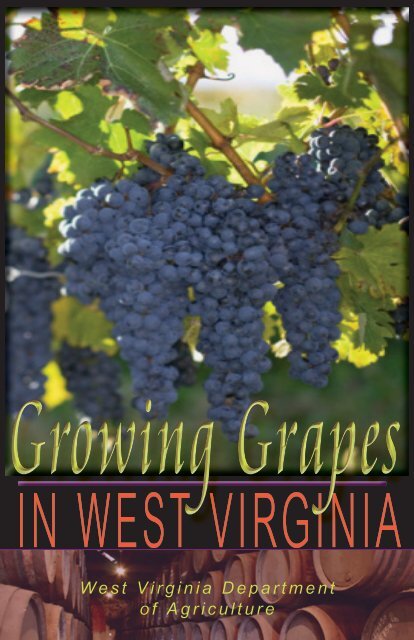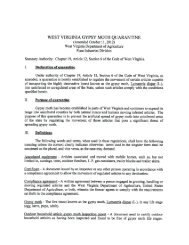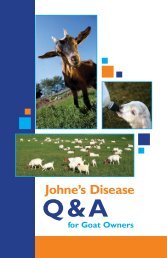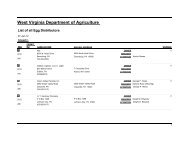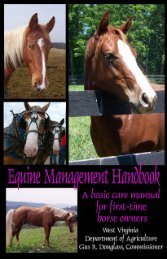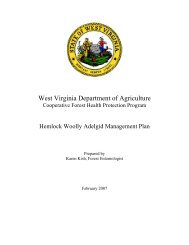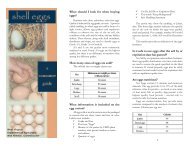Growing Grapes in WV - West Virginia Department of Agriculture
Growing Grapes in WV - West Virginia Department of Agriculture
Growing Grapes in WV - West Virginia Department of Agriculture
Create successful ePaper yourself
Turn your PDF publications into a flip-book with our unique Google optimized e-Paper software.
<strong>Grow<strong>in</strong>g</strong> <strong>Grapes</strong>IN WEST VIRGINIAW e s t V i r g i n i a D e p a r t m e n t<strong>of</strong> <strong>Agriculture</strong>
<strong>Grow<strong>in</strong>g</strong> <strong>Grapes</strong> <strong>in</strong><strong>West</strong> Virg<strong>in</strong>ia<strong>Grapes</strong> are grown <strong>in</strong> <strong>West</strong> Virg<strong>in</strong>ia <strong>in</strong> small-scale commercial andbackyard plant<strong>in</strong>gs. The <strong>in</strong>creased <strong>in</strong>terest <strong>in</strong> grapes for table and w<strong>in</strong>eproduction has led to <strong>in</strong>creased research and cultivar selection by theDivision <strong>of</strong> Plant and Soil Sciences <strong>of</strong> the <strong>West</strong> Virg<strong>in</strong>ia University DavisCollege <strong>of</strong> <strong>Agriculture</strong>, Forestry and Consumer Science. With carefulplann<strong>in</strong>g and management, grapes can be grown <strong>in</strong> <strong>West</strong> Virg<strong>in</strong>ia forhome or pr<strong>of</strong>itable commercial use.Types <strong>of</strong> <strong>Grapes</strong>There are several hundredwidely different cultivars <strong>of</strong> grapesgrown <strong>in</strong> the United States. Thecultivars are grouped <strong>in</strong>to fourtypes: (1) European (Vitis v<strong>in</strong>ifera),(2) American (Vitis labrusca and itsderivatives), (3) Muscad<strong>in</strong>e (Vitisrotundifolia) and (4) French hybrids,crosses <strong>of</strong> V. v<strong>in</strong>ifera cultivars withdisease-resistant wild Americanspecies.The European grape has beendifficult to grow <strong>in</strong> <strong>West</strong> Virg<strong>in</strong>iabecause it is very susceptible tocold <strong>in</strong>jury and requires long, warmsummers for proper fruit maturation.Disease and <strong>in</strong>sect susceptibilityare also serious problems withV. v<strong>in</strong>ifera types. With proper siteselection and tra<strong>in</strong><strong>in</strong>g systems toallow recovery from w<strong>in</strong>ter damage,European grapes can be grown<strong>in</strong> some areas <strong>of</strong> <strong>West</strong> Virg<strong>in</strong>ia.W<strong>in</strong>eries prefer v<strong>in</strong>efera grapes forw<strong>in</strong>e production and will <strong>of</strong>ten pay apremium price for them.-1-The American grape typified bythe cultivar Concord is w<strong>in</strong>ter hardyand disease resistant. Americangrapes are the most commonlygrown grapes east <strong>of</strong> the RockyMounta<strong>in</strong>s. Many new cultivars <strong>of</strong>excellent seedless table grapes,very different from Concord, havebeen developed.Muscad<strong>in</strong>e grapes are mostcommonly grown <strong>in</strong> the southbecause they are only hardy whereotemperatures rarely fall below 10 Fo(-12 C). Few places <strong>in</strong> <strong>West</strong> Virg<strong>in</strong>iameet this requirement. The fruitand culture <strong>of</strong> Muscad<strong>in</strong>e grapes isdifferent from other grapes and willnot be covered <strong>in</strong> this paper.French hybrids are usuallysuperior to American types forw<strong>in</strong>e and are more cold hardy anddisease resistant than Europeantypes. Several <strong>of</strong> these cultivarshave been tested <strong>in</strong> <strong>West</strong> Virg<strong>in</strong>iafor their adaptability to easternclimatic conditions (see section oncultivars).
Locat<strong>in</strong>g the V<strong>in</strong>eyardProper site and soil selectionare critical to good production.The prospective grape grower is<strong>in</strong> most cases already on a farmand has little if any choice <strong>in</strong> thegeneral location for a v<strong>in</strong>eyard,but the grower may have severalpossible sites available onthe farm from which to choose.The v<strong>in</strong>eyard should be locatedaway from natural woodlands, ifpossible, to reduce <strong>in</strong>festation by<strong>in</strong>sects and damage by birds anddeer. It is important that the sitehave good air and water dra<strong>in</strong>age.The slope should be gentleenough to allow easy cultivationand spray<strong>in</strong>g without erosion. Alevel piece <strong>of</strong> land with lower landnearby so that cold air can dra<strong>in</strong><strong>of</strong>f, or a site that has a slope <strong>of</strong>2-3 feet <strong>in</strong> each 100 feet is ideal.Steeper sites should be plantedwith rows follow<strong>in</strong>g the contour.Good air dra<strong>in</strong>age is more essentialwith grapes than with othersmall fruits because, <strong>in</strong> additionto possible frost <strong>in</strong>jury, <strong>in</strong>fectionby such fungus diseases as blackrot is more severe where airdra<strong>in</strong>age is poor.The most desirable exposuremust be decided by the <strong>in</strong>dividualgrower. A southern exposuregives an earlier crop but <strong>in</strong>creasesthe danger <strong>of</strong> <strong>in</strong>jury to the tendershoots from late spr<strong>in</strong>g frost.A northern or eastern exposurereduces the risk <strong>of</strong> frost but givesa later crop. The grower mustdecide if the slightly earlier cropis worth the risk. Market demandswill be an important consideration<strong>in</strong> mak<strong>in</strong>g the choice.A gravelly or sandy loam soilis considered best for grapes,but they will do well on many soiltypes. The soil should have afairly high water-hold<strong>in</strong>g capacity,not be waterlogged at anytime dur<strong>in</strong>g the year, have 3 to 5feet <strong>of</strong> usable depth depend<strong>in</strong>gon texture, be <strong>of</strong> at least mediumfertility and slightly acid. A soil toopoor to grow other crops will notbe satisfactory for a v<strong>in</strong>eyard. TheSoilprospective grower should keepcerta<strong>in</strong> general characteristics <strong>of</strong>soils <strong>in</strong> m<strong>in</strong>d <strong>in</strong> choos<strong>in</strong>g a site.A sandy soil warms up rapidlyand will mature a crop a few daysearlier than will a clay soil but asandy soil tends to be less fertileand to have a smaller water-hold<strong>in</strong>gcapacity. A soil conta<strong>in</strong><strong>in</strong>g toomuch clay will also form a crust<strong>in</strong> hot weather that will adverselyaffect water <strong>in</strong>filtration.-2-
In select<strong>in</strong>g a grape cultivar,you must consider the number <strong>of</strong>grow<strong>in</strong>g degree days, the length<strong>of</strong> the grow<strong>in</strong>g season and thefrequency <strong>of</strong> exposure to lowtemperatures. The time requiredto mature grape fruit varies withlocation and climate and is verydependent on the amount <strong>of</strong> heatexperienced by the v<strong>in</strong>e. Thefrequency <strong>of</strong> very cold weatherwill determ<strong>in</strong>e w<strong>in</strong>ter survival <strong>of</strong>the v<strong>in</strong>es.The grow<strong>in</strong>g degree day(GDD) is used to calculate theamount <strong>of</strong> heat received. It iscalculated as the daily averagetemperature (max + M<strong>in</strong>/2) m<strong>in</strong>usothe base temperature <strong>of</strong> 50 Fbelow which grapes will not grow.Dur<strong>in</strong>g a spr<strong>in</strong>g day with a highoo<strong>of</strong> 80 F and a low <strong>of</strong> 60 F, theGDD+((80+60)/2)-50=20. Theowhole month <strong>of</strong> average 70 Fweather would be equal to 600GDD (30 days x 20=600). YouRegion GDD CultivatarsTemperaturecan approximate the number <strong>of</strong>GDD from the closest weather report<strong>in</strong>gstation (see appendix 1).For every 100 feet elevation, theGDD decreases by approximately70 for a season. If a nearby townexperiences 3000 GDD <strong>in</strong> a yearand your v<strong>in</strong>eyard is 200 feethigher, then your v<strong>in</strong>eyard wouldhave approximately 2860 GDD(3000-(70 x 2)).In general a frost free period<strong>of</strong> 165-180 days is required tomature grape fruit and wood. Theperiod must be long enough toallow harvest <strong>of</strong> the fruit and timefor the wood to acclimate for thew<strong>in</strong>ter. The length <strong>of</strong> the grow<strong>in</strong>gseason is not as important asthe GDD <strong>in</strong> determ<strong>in</strong><strong>in</strong>g cultivaradaptability, as some areaswith long seasons are not warmenough to mature grapes well.W<strong>in</strong>e grow<strong>in</strong>g regions are divided<strong>in</strong>to five zones based solely ontheir GDD accumulations:Table 1. W<strong>in</strong>e grow<strong>in</strong>g regions, their GDD and typical cultivars.I >2500 Chardonnay, P<strong>in</strong>ot, Noir, White Riesl<strong>in</strong>g, Foch,Cayuga, White, most American typesII 2501-3000Above cultivars and Chambourc<strong>in</strong>, Chen<strong>in</strong> Blanc, CabernetSauvignon, Gamay, Seyval, Vidal 256III 3001-3500IV 3501-4000V >4000 Thompson Sdls.Chen<strong>in</strong> Blanc, Refosco, Z<strong>in</strong>fandel, Seyval, Vidal 256Dessert w<strong>in</strong>es, table grapes, rais<strong>in</strong> grapes-3-
Table 2. The expected ten-year frequency <strong>of</strong> cold temperatures relatedto w<strong>in</strong>ter damage hazard.M<strong>in</strong>imum Temperature-5 -10 -15W<strong>in</strong>ter Damage Hazard
Hardwood Cutt<strong>in</strong>gsHardwood cutt<strong>in</strong>gs are themost common method <strong>of</strong> propagation.Cutt<strong>in</strong>gs can be made atany time after leaf drop <strong>in</strong> the falluntil the sap starts to flow <strong>in</strong> thespr<strong>in</strong>g. If the cutt<strong>in</strong>gs are prepared<strong>in</strong> fall or early w<strong>in</strong>ter, there is abetter chance <strong>of</strong> obta<strong>in</strong><strong>in</strong>g goodcallus formation that is critical torapid root formation <strong>in</strong> the spr<strong>in</strong>g.However, good results are sometimesobta<strong>in</strong>ed by mak<strong>in</strong>g cutt<strong>in</strong>gsa week or two before the sap rises<strong>in</strong> the spr<strong>in</strong>g and sett<strong>in</strong>g them outimmediately.Straight, vigorous, wellmatured,one-year-old canes withwell-developed buds should bechosen for cutt<strong>in</strong>gs. The best cutt<strong>in</strong>gsare made from canes aboutpencil-size or slightly larger withfour buds 2-3 <strong>in</strong>ches apart. Thismakes an ideal completed cutt<strong>in</strong>g8 or 12 <strong>in</strong>ches long.In mak<strong>in</strong>g the cutt<strong>in</strong>gs, aslant<strong>in</strong>g cut should be madejust below the lowest bud, and astraight cut should be made aboutone <strong>in</strong>ch above the top bud sothat the top can be easily identifiedand the bud will not dry out.Root<strong>in</strong>g takes place more readilynear buds than on other parts <strong>of</strong>the cane. Usually about 50 percent<strong>of</strong> the cutt<strong>in</strong>g will root so takemore than are required.The completed cutt<strong>in</strong>gsshould be grouped accord<strong>in</strong>g tolength and tied <strong>in</strong> bundles <strong>of</strong> 50with the butt ends together. A fungicidedip is not essential but maybe used to prevent mold dur<strong>in</strong>g-5-storage. They should be clearlylabeled, buried <strong>in</strong> trenches <strong>in</strong> awell-dra<strong>in</strong>ed spot, butt ends up,and covered with 3 to 6 <strong>in</strong>ches <strong>of</strong>soil. Invert<strong>in</strong>g the cutt<strong>in</strong>gs <strong>in</strong>ducescallus<strong>in</strong>g <strong>of</strong> the butt end whilethe top rema<strong>in</strong>s dormant. Afterthe ground freezes, a cover<strong>in</strong>g<strong>of</strong> straw or manure will preventalternate freez<strong>in</strong>g and thaw<strong>in</strong>gwith changes <strong>in</strong> temperature. Thecover<strong>in</strong>g should be removed assoon as the weather warms <strong>in</strong>the spr<strong>in</strong>g.As soon as the ground hasbecome warm <strong>in</strong> the spr<strong>in</strong>g andthere is no danger <strong>of</strong> frost, thesoil should be prepared carefullyto a depth <strong>of</strong> 8-12 <strong>in</strong>chesand the cutt<strong>in</strong>gs set about 5-6<strong>in</strong>ches apart <strong>in</strong> the row and deepenough so that only the top budprotrudes above ground. Thesoil should then be firmed wellaround the cutt<strong>in</strong>g. Weeds shouldbe controlled by hand, with herbicideor black plastic. Irrigationis useful and required <strong>in</strong> mostyears. If plastic is used, preparethe soil <strong>in</strong> ridges, cover with plasticand plant the cutt<strong>in</strong>gs throughthe plastic. Rooted cutt<strong>in</strong>gs canbe dug <strong>in</strong> the fall, graded andstored either by sett<strong>in</strong>g the roots<strong>in</strong> a trench <strong>in</strong> well dra<strong>in</strong>ed soil orstor<strong>in</strong>g under moist conditions ato34 F.Layer<strong>in</strong>g &Graft<strong>in</strong>gLayer<strong>in</strong>g and graft<strong>in</strong>gare sometimes used <strong>in</strong> grapepropagation. Layer<strong>in</strong>g is usedfor certa<strong>in</strong> varieties that do notroot readily from cutt<strong>in</strong>gs and
for fill<strong>in</strong>g <strong>in</strong> vacancies <strong>in</strong> anestablished v<strong>in</strong>eyard. Graft<strong>in</strong>g ispracticed chiefly by nurseries toestablish a cultivar on a differentrootstock and will not be describedhere.In layer<strong>in</strong>g varieties that donot root readily, a narrow trenchabout 10-15 <strong>in</strong>ches deep is dug<strong>in</strong> early spr<strong>in</strong>g where the newplant is desired or where there isroom to produce a nursery plant.A healthy cane <strong>of</strong> the previousseason’s growth, orig<strong>in</strong>at<strong>in</strong>gclose to the ground on aneighbor<strong>in</strong>g v<strong>in</strong>e is bent downto the bottom <strong>of</strong> the trench andvertically back up to br<strong>in</strong>g twoor more tip buds above the soilsurface. Wound<strong>in</strong>g the caneopposite each underground budwill hasten root<strong>in</strong>g. The trench isthen filled to promote root<strong>in</strong>g <strong>of</strong>the cane section below ground.The part <strong>of</strong> the cane connect<strong>in</strong>gthe new plant to the mother plantshould be stripped <strong>of</strong> develop<strong>in</strong>gshoots as they emerge. Onlythe shoots from the buds <strong>of</strong> theprotrud<strong>in</strong>g cane tip should be allowedto grow. The rooted plantscan be severed from the parentv<strong>in</strong>e the follow<strong>in</strong>g spr<strong>in</strong>g and set<strong>in</strong> their permanent location. If therooted plant is to fill the vacancywhere it is rooted, the plantshould not be severed from themother plant until the diameter <strong>of</strong>the new v<strong>in</strong>e trunk exceeds thediameter <strong>of</strong> the bent over caneand fruit should be removed forthe first two years.Rootstocks<strong>Grapes</strong> can be grown on theirown roots or grafted onto a plantthat provides special root characteristics.The primary reasons forus<strong>in</strong>g a rootstock are to provideresistance to phylloxera andnematode parasites on the rootsystem, to isolate the scion cultivarfrom soilborne virus diseases,to <strong>in</strong>duce vigorous growth <strong>in</strong> areplant situation, and to avoidvarietal susceptibility to lime<strong>in</strong>ducedchlorosis. If any <strong>of</strong> thesesituations apply to the plannedv<strong>in</strong>eyard site, rootstocks shouldbe considered.CultivarsGrape cultivars tested <strong>in</strong><strong>West</strong> Virg<strong>in</strong>ia are listed <strong>in</strong> Table3 pages 24-27. Because <strong>of</strong>the diversity <strong>of</strong> climate <strong>in</strong> <strong>West</strong>Virg<strong>in</strong>ia, it is suggested that anycultivar to be planted should betried on a trial basis first. Inclusion<strong>in</strong> this table is not an <strong>in</strong>dicationthat the plants will survive <strong>in</strong>all locations.-6-
Plant<strong>in</strong>g the V<strong>in</strong>eyardSoil PreparationA well-cared-for v<strong>in</strong>eyardwill <strong>of</strong>ten outlive the person whoplanted it. Hence, adequate soilpreparation is very important. Thispreparation should beg<strong>in</strong> at leasta year before the v<strong>in</strong>eyard is tobe set out. It should be designedto subdue weeds, to improve thephysical condition <strong>of</strong> the soil, andto add humus. This is easy to dobefore the v<strong>in</strong>eyard is establishedbut is difficult to do after the v<strong>in</strong>esare <strong>in</strong> place. A soil sample shouldbe taken to determ<strong>in</strong>e potassium,magnesium, soil pH and organicmatter so that adjustments can bemade before plant<strong>in</strong>g. The need forkeep<strong>in</strong>g a relatively high organicmatter content <strong>in</strong> the soil cannotbe overemphasized. A high humuscontent not only is essential forhold<strong>in</strong>g moisture, but it also improvesthe physical condition <strong>of</strong> thesoil. The grow<strong>in</strong>g <strong>of</strong> a short seasoncrop requir<strong>in</strong>g constant cultivation,followed by a fast grow<strong>in</strong>g covercrop to be turned under, and augmentedby the addition <strong>of</strong> as muchbarnyard manure as possible willput the soil <strong>in</strong> a desirable state <strong>of</strong>tilth. Part <strong>of</strong> the manure can be puton the cultivated crop <strong>in</strong> the spr<strong>in</strong>g,the rema<strong>in</strong>der <strong>in</strong> the fall. Leave acover crop on through the w<strong>in</strong>terand turn it under <strong>in</strong> early spr<strong>in</strong>g.Before sett<strong>in</strong>g out the v<strong>in</strong>eyard,poorly dra<strong>in</strong>ed spots that show upwhile the cultivated crop is on theland should be dra<strong>in</strong>ed. If the soilis sufficiently acid to require lim<strong>in</strong>g,i.e., too acid for cover crop growth,lime should be applied about a yearbefore plant<strong>in</strong>g. Troublesome perennialweeds such as quackgrassor morn<strong>in</strong>g-glory should be elim<strong>in</strong>atedwith herbicides before plant<strong>in</strong>ggrapes. If grapes have been grown<strong>in</strong> this site before, at least two years<strong>of</strong> plant<strong>in</strong>g to grass or cover cropsis required to reduce the population<strong>of</strong> grape root pests. Alternatively thesite could be fumigated or vigorousrootstocks used to avoid replantgrowth suppression.LayoutSeveral factors must be considered<strong>in</strong> decid<strong>in</strong>g on the bestplant<strong>in</strong>g distances for a v<strong>in</strong>eyard.First, there should be enoughspace between rows to allow forconvenient tractor cultivation andspray<strong>in</strong>g; second, there shouldbe enough space between plants<strong>in</strong> the row so that adjo<strong>in</strong><strong>in</strong>g v<strong>in</strong>eswill not <strong>in</strong>term<strong>in</strong>gle too much; andthird, sufficient space should beallowed so that there will be littlecompetition between the roots <strong>of</strong>adjo<strong>in</strong><strong>in</strong>g plants for nutrients andwater. V<strong>in</strong>es are generally set 6-8feet apart <strong>in</strong> rows 9 feet apart. Atthe 8 feet spac<strong>in</strong>g, 605 plants peracre will be required, at 7 feet, 690plants and at 6 feet, 807 plants.The first step <strong>in</strong> preparationfor plant<strong>in</strong>g is the lay<strong>in</strong>g out <strong>of</strong>the v<strong>in</strong>eyard. Probably the bestmethod for lay<strong>in</strong>g out a small-7-
or medium v<strong>in</strong>eyard is to use awire or cord marked by a knot atthe desired <strong>in</strong>tervals. By simplymov<strong>in</strong>g the ends <strong>of</strong> the l<strong>in</strong>e overthe distance between rows, smallmark<strong>in</strong>g stakes can be driven atthe knots and the v<strong>in</strong>eyard laid outquickly. Some growers prefer tomark <strong>of</strong>f the outside rows with fivetosix-foot uprights, turn furrowslengthwise and across the field,and set the plants at the <strong>in</strong>tersections<strong>of</strong> these furrows. Othersprefer to sight between outsidestakes. Whatever method is used,it is essential that the v<strong>in</strong>es be set<strong>in</strong> sufficiently straight rows so thatthey will not <strong>in</strong>terfere with culturaloperations after the trellis is <strong>in</strong>place. Adequate headland must beleft at each end <strong>of</strong> the site for trellisanchor<strong>in</strong>g and equipment turn<strong>in</strong>g.The rows should run northand south unless there is a goodreason for do<strong>in</strong>g otherwise. Thiswill lead to better light exposure,dry<strong>in</strong>g and disease control. Therows should not run at right anglesto strong prevail<strong>in</strong>g w<strong>in</strong>ds thatmight cause damage by whipp<strong>in</strong>gthe shoots about. The v<strong>in</strong>es shouldfollow the contour <strong>of</strong> a fairly steepsite, or at least run across the hillrather than up and down.At convenient <strong>in</strong>tervals a rowshould be left out to form an alleythat will facilitate harvest<strong>in</strong>gand cultural operations. The alleyshould divide the v<strong>in</strong>eyard <strong>in</strong>toblocks about twice as long as theyare wide. If the field is long, 25-footcross alleys at 1,000 foot <strong>in</strong>tervalsare also desirable to facilitate harvest<strong>in</strong>gand fertiliz<strong>in</strong>g.In <strong>West</strong> Virg<strong>in</strong>ia, grapes should-8-generally be set <strong>in</strong> early spr<strong>in</strong>g toavoid w<strong>in</strong>ter kill <strong>of</strong> fall set plants.Care should be taken to see thatthe plants do not dry out. Whenthe plants are received from thenursery, the bundles should beopened and the roots soaked forseveral hours if they seem dry. Ifthe ground is not prepared andcannot be prepared with<strong>in</strong> a dayor two, the young v<strong>in</strong>es should beheeled <strong>in</strong> or held under refrigerationuntil ready for sett<strong>in</strong>g. Whencarried to the field, they should bekept <strong>in</strong> a pail <strong>of</strong> water or a wet sackand should not be dropped far <strong>in</strong>front <strong>of</strong> the planters. Damaged andexcessively long roots should bepruned back before a v<strong>in</strong>e is set.A crew <strong>of</strong> four persons shouldbe used for sett<strong>in</strong>g grapev<strong>in</strong>es ifpossible - two to dig holes, one tohold the v<strong>in</strong>e and tamp the soil,and one to backfill. The holesshould be wide enough so that theroots can be spread out and deepenough for the v<strong>in</strong>e to stand a littledeeper than it did <strong>in</strong> the nurseryrow. Make sure the graft union isabove ground if grafted plants areused. A little surface soil should beplaced around the roots <strong>in</strong> the bottom<strong>of</strong> the hole, and the soil shouldbe firmed as the hole is filled <strong>in</strong>to ensure good root-soil contact.Fertilizer should not be placed <strong>in</strong>the holes. After plant<strong>in</strong>g and afterdanger <strong>of</strong> frost, the v<strong>in</strong>e shouldbe pruned to one strong, two-budcane.Most grapes are self-fertile andbear well <strong>in</strong> isolated blocks, but afew, for example Brighton, require<strong>in</strong>terplant<strong>in</strong>gs <strong>of</strong> poll<strong>in</strong>izers suchas Concord.
Weed ControlGrapev<strong>in</strong>es are more shallowrootedthan trees. Consequently,they are more affected by compet<strong>in</strong>gweeds. To get the early v<strong>in</strong>e growthneeded for best yields, cultivation orherbicide strips are an establishedpractice <strong>in</strong> commercial v<strong>in</strong>eyards.The tim<strong>in</strong>g <strong>of</strong> weed control orcover crop reduction between rowscan be used as a tool to <strong>in</strong>fluencev<strong>in</strong>e growth. Weed and cover cropgrowth reduce water availability tothe v<strong>in</strong>e and slow v<strong>in</strong>e growth. Reduc<strong>in</strong>gweed and cover crop growthstimulates v<strong>in</strong>e growth by <strong>in</strong>creas<strong>in</strong>gsoil water availability. Clean cultivationwill also <strong>in</strong>crease temperaturesaround v<strong>in</strong>es on frost susceptiblesites.Several herbicides are registeredfor use on grapes. Thereare three basic types <strong>of</strong> herbicidesused: residual, soil-act<strong>in</strong>gtypes such as simaz<strong>in</strong>e, contactherbicides such as paraquat andsystemic herbicides such as glyphosate.Residual herbicides areused to control weeds before theygerm<strong>in</strong>ate. Contact and systemicherbicides are used to control establishedweeds. Care must be taken toavoid apply<strong>in</strong>g herbicides to foliage.Consult your <strong>West</strong> Virg<strong>in</strong>ia UniversityExtension Service specialist orcounty agent and the herbicide labelfor details and recommendations.Cover CropsV<strong>in</strong>eyard Soil Culture-9-One <strong>of</strong> the serious problems<strong>in</strong> the grape v<strong>in</strong>eyard is the ma<strong>in</strong>tenance<strong>of</strong> the humus supply. Annualcover crops will help to ma<strong>in</strong>ta<strong>in</strong>the organic matter <strong>in</strong> the soil.Humus may also be <strong>in</strong>creased byapply<strong>in</strong>g barnyard manure, wastehay, straw and pomace plus stemswith the chopped prun<strong>in</strong>gs.A cover crop lessens soilerosion and the leach<strong>in</strong>g <strong>of</strong> valuablesoil nutrients and it promotesearlier harden<strong>in</strong>g <strong>of</strong> wood <strong>in</strong> shortseasonlocations. In the bear<strong>in</strong>gv<strong>in</strong>eyard the cover crop shouldbe sown at the last cultivation <strong>in</strong>August. Domestic rye grass, rye,wheat, barley and vetch are commonlygrown. If the cover crop issown under the trellis, perennialssuch as rye may become a weedproblem. Cold-susceptible coversare useful <strong>in</strong> these situations.Complete commercial fertilizersmay be used to get a goodcover crop. An application <strong>of</strong>100-250 pounds <strong>of</strong> a 10-20-10fertilizer per acre is recommendedfor small gra<strong>in</strong>s such as rye, and150-200 pounds <strong>of</strong> a 0-20-10fertilizer for legumes.The Hillside V<strong>in</strong>eyardA system <strong>of</strong> clean cultivationis difficult to carry out <strong>in</strong> v<strong>in</strong>eyardlocated on hillsides. Some earlyspr<strong>in</strong>g cultivation may be given <strong>in</strong>such v<strong>in</strong>eyards if rows have beenlaid out on the contour system andif some terrac<strong>in</strong>g was done. If muchsoil erosion occurs, mowed sodcover should be planted every rowor every alternate row depend<strong>in</strong>gon v<strong>in</strong>e size and vigor. With<strong>in</strong> therow the soil should be cultivated or
weeds controlled with herbicides.The more sod, the greater thereduction <strong>in</strong> v<strong>in</strong>e growth. On lesssteep slopes, trashy cultivation maybe the best alternative. In this methoda disc or rotary mower is runthrough the v<strong>in</strong>eyard <strong>of</strong>ten enoughto keep the weeds and grass fromcompet<strong>in</strong>g with the grapes, but theground is never left bare. In general,fruit production will not average ashigh from hillside v<strong>in</strong>eyards as fromthose on more level land becauseit is more difficult to thoroughlycultivate hillsides. Where mulch<strong>in</strong>gmaterials are cheap and plentiful,mulch<strong>in</strong>g may be the best method<strong>of</strong> soil management <strong>in</strong> hillside v<strong>in</strong>eyards.FertilizerSoil fertility should be determ<strong>in</strong>edfrom soil sample analysisprior to plant<strong>in</strong>g. After plant<strong>in</strong>g, soiltests are not a dependable method<strong>of</strong> identify<strong>in</strong>g nutrient deficiencies.The nutritional status <strong>of</strong> the v<strong>in</strong>escan best be determ<strong>in</strong>ed from petioleanalysis after plant<strong>in</strong>g. Petioles (leafstems) are collected from the youngestmature leaves <strong>of</strong> exposed bear<strong>in</strong>gprimary shoots dur<strong>in</strong>g August.They sample should reflect typicalv<strong>in</strong>es. If some v<strong>in</strong>es are show<strong>in</strong>gsymptoms <strong>of</strong> nutrient deficiencies,these should be sampled separately.Contact the extension agent orspecialist for further <strong>in</strong>formation oncollect<strong>in</strong>g petiole samples. A history<strong>of</strong> fertilizers applied and petioleanalysis results are useful <strong>in</strong> decid<strong>in</strong>gon future fertilizer applications.Soil fertility <strong>in</strong> the v<strong>in</strong>eyard maybe best ma<strong>in</strong>ta<strong>in</strong>ed by the use <strong>of</strong>manure and pomace when used atrates <strong>of</strong> 5-15 tons/acre. Some form<strong>of</strong> commercial fertilizer should be-10-used if there is <strong>in</strong>sufficient manure.Nitrogen is generally the elementlack<strong>in</strong>g; hence, marked responseswill be obta<strong>in</strong>ed by applications <strong>of</strong>urea, ammonium sulfate or ammoniumnitrate. Cost per unit <strong>of</strong> nitrogenshould determ<strong>in</strong>e the selection <strong>of</strong>the form used. Forty to 60 pounds <strong>of</strong>actual nitrogen per year is a generalrecommendation, and applicationsshould never be greater than 80pounds actual nitrogen per year. A200-300 pound application <strong>of</strong> ammoniumsulfate per acre (about onehalflb. per v<strong>in</strong>e) made <strong>in</strong> the spr<strong>in</strong>gis an average recommendation forv<strong>in</strong>e ma<strong>in</strong>tenance on high-lime soils.Nitrogen fertilizer should be applied2-3 weeks before the anticipated budbreak so that there is sufficient nitrogen<strong>in</strong> the plant for strong growthat bud break. After establishment<strong>of</strong> v<strong>in</strong>e size, apply fertilizers only asrecommended by tissue analysis.Complete fertilizers should beused on the cover crop only, as potassiumand phosphorus need onlybe applied to the grapes when tests<strong>in</strong>dicate they are lack<strong>in</strong>g. Potassium,magnesium or manganesedeficiencies should be corrected assoon as discovered with rates <strong>of</strong> fertilizerdeterm<strong>in</strong>ed by the severity <strong>of</strong>the symptoms. Petiole analysis candetect <strong>in</strong>cipient deficiencies so theycan be corrected before symptomsappear.In new plant<strong>in</strong>gs, a fertilizersuch as ammonium sulfate shouldbe spread uniformly <strong>in</strong> a circulararea around each v<strong>in</strong>e, start<strong>in</strong>ga few <strong>in</strong>ches from the trunk andextend<strong>in</strong>g out to a distance <strong>of</strong> a fewfeet. Broadcast applications maybe used after the first year, as v<strong>in</strong>eroots extend throughout the soilvolume.
Tra<strong>in</strong><strong>in</strong>g and Prun<strong>in</strong>gBefore attempt<strong>in</strong>g to tra<strong>in</strong> or prune a grapev<strong>in</strong>e, certa<strong>in</strong> pr<strong>in</strong>ciplesmust be understood to achieve the desired results. Prun<strong>in</strong>g is the removal<strong>of</strong> wood to regulate fruit production. Tra<strong>in</strong><strong>in</strong>g is the removal <strong>of</strong> wood <strong>in</strong>such as way as to shape the v<strong>in</strong>e so that it will bear a good crop withoutbreak<strong>in</strong>g and will not <strong>in</strong>terfere with cultural operations.<strong>Grapes</strong> are vigorous plants that require the removal <strong>of</strong> 80-90 percent<strong>of</strong> the new wood after establishment to balance fruit<strong>in</strong>g and vegetativegrowth. All prun<strong>in</strong>g should be done while the v<strong>in</strong>es are dormant, preferablya short time before the sap beg<strong>in</strong>s to circulate <strong>in</strong> the spr<strong>in</strong>g. W<strong>in</strong>ter<strong>in</strong>juredwood may then be identified and removed.Tra<strong>in</strong><strong>in</strong>g Young V<strong>in</strong>esp<strong>in</strong>g. If v<strong>in</strong>es do not produce 3/4pounds <strong>of</strong> prun<strong>in</strong>gs, the recom-First year: Prune back to fourmendations for the second yearbuds at plant<strong>in</strong>g. After danger <strong>of</strong>tra<strong>in</strong><strong>in</strong>g should be repeated.frost, cut back to two liv<strong>in</strong>g buds.A second cane orig<strong>in</strong>at<strong>in</strong>gSecond year: Dur<strong>in</strong>g thefrom the very base <strong>of</strong> the v<strong>in</strong>e candormant season follow<strong>in</strong>g the firstnow be reta<strong>in</strong>ed and pruned to thegrow<strong>in</strong>g season, a s<strong>in</strong>gle goodbottom wire if a double trunk sys-cane should be chosen to formtem is desired for areas with fre-the ma<strong>in</strong> trunk and attached toquent w<strong>in</strong>ter <strong>in</strong>jury. In these areasthe top wire if possible. When thethe tra<strong>in</strong><strong>in</strong>g systems are done withbuds burst, 6 to 10 shoots shouldtwo trunks. If one trunk is killed bybe reta<strong>in</strong>ed on the upper portionw<strong>in</strong>ter <strong>in</strong>jury, mechanical damage<strong>of</strong> the trunk if tra<strong>in</strong><strong>in</strong>g systemsor eutypa dieback disease, it cansuch as umbrella Kniff<strong>in</strong>, Hudsonbe removed with little effect onRiver umbrella, or Geneva doubleproduction. Dur<strong>in</strong>g the third grow-curta<strong>in</strong> are be<strong>in</strong>g considered, or<strong>in</strong>g season, all but two or threeat the proper position for arms orshoots near the top <strong>of</strong> this caneother tra<strong>in</strong><strong>in</strong>g systems. All othershould be removed shortly aftershoots should be removed toshoot growth commences. In laterconcentrate growth <strong>in</strong> the canesyears this second trunk is pruneddesired for future tra<strong>in</strong><strong>in</strong>g. Allas a mirror image <strong>of</strong> the otherflower clusters should be removedtrunk and both are considered asas they develop to allow the plantone plant <strong>in</strong> count<strong>in</strong>g buds.to become established beforebear<strong>in</strong>g a crop.Pr<strong>in</strong>ciplesThird year: V<strong>in</strong>es that produce3/4 pounds or more <strong>of</strong> prun<strong>in</strong>gThe pr<strong>in</strong>ciples <strong>of</strong> prun<strong>in</strong>gshould be balance pruned and <strong>in</strong>dicate what wood to leave, howfruited <strong>in</strong> the third year. Flower much to leave, and where to leaveclusters should be th<strong>in</strong>ned to one it on mature v<strong>in</strong>es. In brief theyper shoot to prevent over crop-are as follows:-11-
1. The fruit is borne onshoots produced from oneyear-oldwood. One-year-oldwood is brown, reddish-brown,or gray, depend<strong>in</strong>g on thevariety, and the bark is tightand not peel<strong>in</strong>g. The amount<strong>of</strong> wood older than one yearshould be kept to a m<strong>in</strong>imum t<strong>of</strong>orm the framework for hold<strong>in</strong>gthe fruit<strong>in</strong>g wood.2. Severe prun<strong>in</strong>g results<strong>in</strong> an excess <strong>of</strong> wood and littlefruit, although both berries andclusters will be large. Lightprun<strong>in</strong>g results <strong>in</strong> the production<strong>of</strong> little wood and a largenumber <strong>of</strong> small clusters <strong>of</strong>small fruit. A balance betweenwood and fruit production isdesired to give a good crop<strong>of</strong> large clustered fruit andenough wood for good canesthe follow<strong>in</strong>g season. The number<strong>of</strong> buds to leave is cultivardependent. For most cultivars30 buds should be left for thefirst pound <strong>of</strong> one-year-oldwood prun<strong>in</strong>gs removed and10 buds left for every pound <strong>of</strong>prun<strong>in</strong>gs after that. If you remove3 pounds <strong>of</strong> one-year-oldwood, then there should be 50buds left on the v<strong>in</strong>e. These 50buds may be ten 5-bud spursor five 10-bud canes depend<strong>in</strong>gon your tra<strong>in</strong><strong>in</strong>g system.This allows a balance that willvary with the vigor <strong>of</strong> the plant.To do this, most <strong>of</strong> the woodis removed, leav<strong>in</strong>g more thanyou th<strong>in</strong>k should be left. Afterweigh<strong>in</strong>g what has been taken-12-<strong>of</strong>f, the buds rema<strong>in</strong><strong>in</strong>g canbe counted and more woodpruned <strong>of</strong>f to adjust the number<strong>of</strong> buds rema<strong>in</strong><strong>in</strong>g to fit the balancedprun<strong>in</strong>g equation.3. The best canes to keepfor fruit<strong>in</strong>g are those <strong>of</strong> mediumsize (about the size <strong>of</strong> a pencil)with plump buds. Canes with adiameter <strong>of</strong> one-fourth to onethird<strong>in</strong>ch and an <strong>in</strong>ternodallength <strong>of</strong> five to eight <strong>in</strong>ches(<strong>in</strong>ternode lengths are shorteron v<strong>in</strong>ifera and French hybridcultivars)-both measured betweenthe fifth and sixth nodesfrom the base - are consideredideal.4. The most productivebuds on the canes are cultivardependent, but generally thethird to n<strong>in</strong>th buds will produceshoots with the most flowers.5. The bear<strong>in</strong>g wood shouldbe close to the ma<strong>in</strong> trunk.This saves space and limits theuptake <strong>of</strong> plant food by unfruitfulwood. Choose wood andrenewal spurs (canes prunedto 2-3 buds to provide canesfor fruit<strong>in</strong>g the next year) closeto the permanent tra<strong>in</strong><strong>in</strong>g structure.Permanent structures<strong>in</strong>clude the ma<strong>in</strong> trunk andbranches (short arms or longcordons) that the fruit<strong>in</strong>g woodorig<strong>in</strong>ates from.Flower-ClusterTh<strong>in</strong>n<strong>in</strong>gFlower-cluster th<strong>in</strong>n<strong>in</strong>g is theremoval by hand <strong>of</strong> some <strong>of</strong> theflower clusters on each shoot to
control crop load. This is mosteffectively done when the clustersfirst appear. Clusters are removedto <strong>in</strong>crease the vigor <strong>of</strong> very weakv<strong>in</strong>es and to reduce excessivecrops on vigorous v<strong>in</strong>es. Early reduction<strong>in</strong> crop load will allow therema<strong>in</strong><strong>in</strong>g fruit to be larger, ripenearlier and have higher sugarsthan fruit on over cropped v<strong>in</strong>es.Clusters are usually th<strong>in</strong>ned toone cluster per shoot.Growth regulators are alsoused to control fruit size. Gibberellicacid is a natural plant hormoneusually produced by seeds. Mostseedless grapes respond togibberellic acid with an <strong>in</strong>crease<strong>in</strong> berry size. In some cultivars,such as Canadice, the <strong>in</strong>creasedberry size can result <strong>in</strong> excessivecompactness and berry crack<strong>in</strong>g.Concord seedless also reactsunfavorably. Gibberellic acid isapplied at mid bloom and at fruitset, usually about 7-10 days afterbloom, to reduce berry numberand <strong>in</strong>crease berry size.Seeded grape cultivars mayrespond to gibberellic acid withreduced cluster compactness andtherefore a reduction <strong>in</strong> bunchrot <strong>in</strong> cultivars with very compactclusters. In seeded grapes,gibberellic acid is applied whenshoots are 4 to 6 <strong>in</strong>ches long.Consult the label before use becausesome seeded cultivars vary<strong>in</strong> their response to gibberellicacid. Misapplication <strong>of</strong> gibberellicacid can result <strong>in</strong> <strong>in</strong>creased w<strong>in</strong>terdamage and reduced bud fruitfulness<strong>in</strong> the year follow<strong>in</strong>g application.Label recommendationsshould be strictly followed.SystemsThere are many different waysto tra<strong>in</strong> grape v<strong>in</strong>es. Research andexperience have shown that theJudson River umbrella or Genevadouble curta<strong>in</strong> are best for mediumto large vigorous v<strong>in</strong>es <strong>of</strong> Concordand similar varieties. Four armKniff<strong>in</strong>, cordon and other tra<strong>in</strong><strong>in</strong>gsystems are acceptable for smallerv<strong>in</strong>es. In choos<strong>in</strong>g which system,several considerations should bekept <strong>in</strong> m<strong>in</strong>d. V<strong>in</strong>es that are tra<strong>in</strong>edon two wires, one above the other,will have less growth and loweryields on the lower wire because<strong>of</strong> shad<strong>in</strong>g from the canes above.Renewal spurs should be <strong>in</strong> highlight environments to produce goodcanes for the next year's crop.Cultivars with large leaves anddroop<strong>in</strong>g shoots, such as Concord,Niagara, and Fredonia, should havethe head or renewal area <strong>of</strong> the v<strong>in</strong>eat the top wire to get the best lightexposure. Cultivars with uprightshoots and small leaves can bettertolerate hav<strong>in</strong>g the renewal areaat the middle wire <strong>of</strong> a three-wiretrellis because there is less shad<strong>in</strong>g.Cane bend<strong>in</strong>g as used <strong>in</strong> umbrellaKniff<strong>in</strong> will <strong>in</strong>crease bud break alongthe canes or vigorous v<strong>in</strong>es, butshould not be used with weak v<strong>in</strong>es<strong>of</strong> any cultivar. In all systems, thefoliage should be uniformly distributedalong the trellis and over itsfull height to a depth <strong>of</strong> not morethan one and one-half to two layers<strong>of</strong> leaves for effective exposure tosunlight.-13-
Geneva Double Curta<strong>in</strong>:This system utilizes a 4-footcross arm on the trellis todouble the amount <strong>of</strong> canopyper row and a s<strong>in</strong>gle wireabout 3 feet high to supportthe trunk (Fig. 1). V<strong>in</strong>es aretra<strong>in</strong>ed to alternate sides <strong>of</strong>the 6-foot high trellis. Eachv<strong>in</strong>e has a 6-8 foot cordon(permanent branch on eitherside <strong>of</strong> the ma<strong>in</strong> trunk,or trunks that is secured by two to four wraps around the support wirewith a wire tie at its end. Each cordon has 10-12 short (4-6 bud) canesevenly spaced along its length. A renewal spur should be kept as nextyear's replacement for each <strong>of</strong> the short canes.Four Arm Kniff<strong>in</strong>: This system utilizes two wires at 3 and 6 feet fromthe orchard floor (Fig. 2).At prun<strong>in</strong>g, four canes andfour renewal spurs shouldbe reta<strong>in</strong>ed. The canesshould orig<strong>in</strong>ate a few <strong>in</strong>chesbelow the wire they are tobe tra<strong>in</strong>ed on and be 8-12nodes long. Two to 6 canesmay be reta<strong>in</strong>ed depend<strong>in</strong>gon variety, can vigor and v<strong>in</strong>espac<strong>in</strong>g.Umbrella Kniff<strong>in</strong>: This systemuses the same trellis as thefour arm Kniff<strong>in</strong>; however,the canes all orig<strong>in</strong>ate fromthe head or top <strong>of</strong> the v<strong>in</strong>e(Fig.3). The top <strong>of</strong> the v<strong>in</strong>eshould reach to 6-12 <strong>in</strong>chesblow the top wire. From thishead region, one to six canes<strong>of</strong> 8-15 buds are bent sharplyover the top wire and tieddown to the lower wire. Each cane reta<strong>in</strong>ed should have a renewalspur reta<strong>in</strong>ed nearby on the head <strong>of</strong> the v<strong>in</strong>e.-14-
Bilateral Cordon: This systemis similar to the Geneva doublecurta<strong>in</strong> only it is a s<strong>in</strong>gle curta<strong>in</strong>(Fig. 4). In this system the ma<strong>in</strong>v<strong>in</strong>e is tra<strong>in</strong>ed up to the top wireand two cordons are tra<strong>in</strong>edout from it toward the adjacentv<strong>in</strong>es. Each cordon is three t<strong>of</strong>our feet long and has 5-6 shortcanes or spurs that can besummer tied to the lower wireif needed. The cordon should also have an equal number <strong>of</strong> renewalspurs spaced along its length.Two-Wire Vertical Trellisfor <strong>Grapes</strong>The basic two-wire trellis is 5feet high and is designed ma<strong>in</strong>lyfor the four-cane kniff<strong>in</strong> system.S<strong>in</strong>gle-span brace or tie-backassemblies may be used. Wirespac<strong>in</strong>g from the ground up is 30and 28 <strong>in</strong>ches. L<strong>in</strong>e post spac<strong>in</strong>g is20 to 30 feet. High tensile 200,000PSI 12 1/2 gauge fence and trelliswire tensioned to a m<strong>in</strong>imum <strong>of</strong>250 pounds can provide adequatesupport for trellis lengths up to4,000 feet. Properly constructedend brace assemblies are a mustfor any grape trellis, but becomemore important as the trellis length<strong>in</strong>creases.General trellis componentspecifications are given <strong>in</strong> Figure 5.The trellis can also be constructedwith different size posts, number <strong>of</strong>wires and post spac<strong>in</strong>gs to accommodateheavier fruit loads.The end post <strong>in</strong> the tie-backbrace assembly is driven at aTrellis<strong>in</strong>g-15-30-degree angle from vertical, oppositethe direction <strong>of</strong> pull <strong>of</strong> thel<strong>in</strong>e wires. For a 58-<strong>in</strong>ch high trellisa 4-<strong>in</strong>ch diameter, 9 foot long postshould be used <strong>in</strong> unstable soil, an8 foot post <strong>in</strong> stable soil. The angleto drive the post can be determ<strong>in</strong>edby sett<strong>in</strong>g the post vertically atground level and mark<strong>in</strong>g a 58-<strong>in</strong>chheight on the post. Attach a plumbl<strong>in</strong>e at this mark and lean the postuntil the plumb l<strong>in</strong>e is 32 <strong>in</strong>ches(horizontally) away from the post.The post is driven at this angleuntil the top is 58 <strong>in</strong>ches (vertically)above the ground.The 6-foot long x 4- to 5-<strong>in</strong>chdiameter tie-back post is drivenvertically to a 4- to 5- foot depth ata 28-<strong>in</strong>ch horizontal distance fromthe plumb l<strong>in</strong>e location. With thel<strong>in</strong>e wires attached to the tie-backpost 6 <strong>in</strong>ches above ground, theend post, top l<strong>in</strong>e wire and horizontalprojection <strong>of</strong> the two l<strong>in</strong>e wiresfrom the tie-back post towardthe end post form an equilateraltriangle.
-16-
Geneva Curta<strong>in</strong>-TypeTrellis for <strong>Grapes</strong>The Geneva Curta<strong>in</strong> trellisis a three-wire T-shaped trellisdesigned for high production andmechanical harvest<strong>in</strong>g, usuallyon relatively flat terra<strong>in</strong>. S<strong>in</strong>glespan brace or tie-back assembliesproperly constructed can supporttrellises up to 4,000-foot length.L<strong>in</strong>e posts spaced 20-30 feet apart,depend<strong>in</strong>g on terra<strong>in</strong>, providesupport for the 12-1/2 gauge hightensile support wires.Wire spac<strong>in</strong>g from the groundup for the vertical support wiresis 26, 26 and 20 <strong>in</strong>ches. A 4-footlong cross-arm is used to supporttwo upper support wires placed 22<strong>in</strong>ches out from the post. Theseupper support wires are at a72-<strong>in</strong>ch height above ground. Allwires are tensioned to a m<strong>in</strong>imum<strong>of</strong> 250 pounds. L<strong>in</strong>e posts shouldbe placed closer together on roll<strong>in</strong>gterra<strong>in</strong> to ma<strong>in</strong>ta<strong>in</strong> a uniform wireheight.General trellis componentspecifications are given <strong>in</strong> Figure6. The trellis can be modified to accommodatedifferent requirements.-17-
Harvest<strong>in</strong>g<strong>Grapes</strong> should be picked whenthe fruit reaches the desired ripenessfor its <strong>in</strong>tended purpose. Asthe fruit ripens, the color changes,the sugars <strong>in</strong>crease and the acidsdecrease. The tim<strong>in</strong>g will vary fromyear to year. Berries should besampled daily as the harvest approachesto determ<strong>in</strong>e sugar, acidand pH. To sample, randomly collect100 to 200 representative berriesfor each cultivar. Acids decreaserapidly under warm conditions andfruit quality can change rapidly.To harvest the grapes a grapeknife or harvest<strong>in</strong>g shears are used.Hold the grapes with one hand andcut with a rapid upward cut awayfrom your hands and arms to prevent<strong>in</strong>jury. Hand shears are saferbut are slower and more difficult touse. Do not jerk or pull clusters fromthe v<strong>in</strong>e as this will crush some <strong>of</strong>the fruit. Discard all green, immatureor diseased fruit. Gently placethe fruit <strong>in</strong>to harvest<strong>in</strong>g lugsor boxes and handle as littleas possible. Take the conta<strong>in</strong>ers<strong>in</strong>to the shade as soon aspossible to reduce fruit temperatures.<strong>Grapes</strong> should be takento the w<strong>in</strong>ery the same day theyare picked.<strong>Grapes</strong> will keep severalweeks after maturity on the v<strong>in</strong>eor if picked and stored <strong>in</strong> a verycool, dry, well-ventilated place.As long as there is no dropp<strong>in</strong>g<strong>of</strong> the berries it is best to leavethe crop on the v<strong>in</strong>es and pickas the market demands. Unlessweather is ra<strong>in</strong>y, there will be nodeterioration. If well-protectedby foliage, grapes will standcold weather (but not a frost).However, birds and bees molest<strong>in</strong>gthe crop must be considered<strong>in</strong> the decision as to whether ornot the mature crop is left on thev<strong>in</strong>e.Pest ManagementBirds are common problems <strong>in</strong> Shotguns are one methodv<strong>in</strong>eyards. They may eat the entire <strong>of</strong> controll<strong>in</strong>g birds, howeverberry or damage the fruit by claw<strong>in</strong>g many birds are protected by law.or peck<strong>in</strong>g. The severity <strong>of</strong> damage Gas exploders and electronicis related to cultivar, degree <strong>of</strong> ripeness,amount <strong>of</strong> foliage hid<strong>in</strong>g the orchard frequently, have simi-noisemakers, if moved about thefruit and proximity to bird roost<strong>in</strong>g lar effects. Other scare devicessites. Small isolated v<strong>in</strong>eyards with such as hawk kits, scare eyes,early ripen<strong>in</strong>g cultivars are the most distress tapes and bird bombssusceptible to damage. Monitor bird can be used <strong>in</strong> comb<strong>in</strong>ation withdamage as the fruit beg<strong>in</strong> to change gas cannons to improve theircolor. Early detection is critical <strong>in</strong> effectiveness. Bird nett<strong>in</strong>g is thecontrol efforts. Many systems are most effective method for controll<strong>in</strong>gbirds, but is expensive andavailable to control birds, but noneis completely successful.cumbersome.-18-
DeerIn areas with adjacent woodlands,deer can cause significant damage tothe v<strong>in</strong>es and foliage. Many repellentshave been tried, but none iscompletely successful. Fenc<strong>in</strong>g is themost effective method <strong>of</strong> keep<strong>in</strong>g deerout <strong>of</strong> the v<strong>in</strong>eyard. There are severalfence design alternatives from lowcost electric spider fences, to 6 wireelectric fences or 8-foot high or highernonelectric fences. See “Deer and <strong>Agriculture</strong><strong>in</strong> <strong>West</strong> Virg<strong>in</strong>ia,” Publication809-810, for more <strong>in</strong>formation.DiseasesBlack rot (Guignardia bidwellii)is the most important disease<strong>of</strong> grapes <strong>in</strong> <strong>West</strong> Virg<strong>in</strong>ia. Thefungus attacks the leaves, stemand tendrils <strong>in</strong> the spr<strong>in</strong>g. Earlysymptoms <strong>of</strong> the disease are smallbrown or black spots that cause noserious damage and are seldomnoticed. Later the fungus spreads tothe fruit, where it is still not noticeableuntil the berries are about halfgrown. Between this period and fruitripen<strong>in</strong>g the severity <strong>of</strong> the disease<strong>in</strong>creases very rapidly and the fruitf<strong>in</strong>ally turns black and shrivels. Thedisease overw<strong>in</strong>ters <strong>in</strong> those shriveledberries (mummies) and on thedead tendrils and canes, so theseshould be removed and destroyedat prun<strong>in</strong>g time. Careful spray<strong>in</strong>g willkeep this disease under control.Botrytis (Botrytis c<strong>in</strong>erea) is theother major fungus that will attackfruit. Infection first occurs dur<strong>in</strong>gflower<strong>in</strong>g and is not apparent untillater <strong>in</strong> the season. S<strong>in</strong>gle berrieswill turn brown and rot. Sporemasses are a characteristic graythat will cover the affected area.Sporulation is enhanced by ra<strong>in</strong>,-19-free moisture on the berries andhigh humidity (above 92%). Thefungus will not grow at temperaturesabove 94oF. The fungus overw<strong>in</strong>ters<strong>in</strong> the <strong>in</strong>fected berries or clustersand spores are spread by air aftermoist weather <strong>in</strong> the spr<strong>in</strong>g. Botrytisis best controlled by an <strong>in</strong>tegratedprogram. Reduce overw<strong>in</strong>ter<strong>in</strong>g<strong>in</strong>oculum by remov<strong>in</strong>g grape mummiesat prun<strong>in</strong>g and disc<strong>in</strong>g themunder. Fungicides at bloom timeare most effective. V<strong>in</strong>es shouldnot be spr<strong>in</strong>kler irrigated once thefruit beg<strong>in</strong> to ripen to avoid moistureon the berries. An open canopythat allows air circulation will alsokeep fruit drier and reduce <strong>in</strong>fectionconditions.Powdery mildew and other fungusdiseases are controlled by fungicidesapplied at regular <strong>in</strong>tervals.InsectsThe grape leafhopper (Erythroneuraspp.) is a small, light-green,suck<strong>in</strong>g <strong>in</strong>sect that can be found <strong>in</strong>almost all v<strong>in</strong>eyards from late Mayand early June until fall. Adults havered, yellow or black mark<strong>in</strong>gs andoverw<strong>in</strong>ter <strong>in</strong> dead grass, underleaves, or <strong>in</strong> rubbish piles. Theyemerge as soon as it is warm <strong>in</strong>the spr<strong>in</strong>g. They live on strawberry,blackberry, and raspberry leavesuntil the grape leaves open. Theysuck the sap through the lowersurface <strong>of</strong> the leaves and causesmall, pale spots to appear. Whenthe <strong>in</strong>sects are numerous, the leafhas a mottled appearance and mayeventually dry up and fall. Clean<strong>in</strong>gup rubbish piles and spray<strong>in</strong>g willhelp control this pest.The grape berry moth (Endopizeviteana Clemens) is theworm usually found when grapes
are wormy at harvest time. It is adark-colored caterpillar. It passesthe w<strong>in</strong>ter <strong>in</strong> the pupal stage onfallen leaves. It emerges about thetime the grapes are blossom<strong>in</strong>g.There are two broods. The first eatsthe stems and external portions <strong>of</strong>the young berries. The caterpillars<strong>of</strong> the second brood live entirely <strong>in</strong>the berries. They attack all cultivars.They are most <strong>in</strong>jurious to thosecultivars that have compact clusterss<strong>in</strong>ce they tend to be protected <strong>in</strong>such clusters and can feed readilyon more than one berry. Some<strong>of</strong> the <strong>in</strong>jured grapes fall from theclusters; the rest must be discardedat harvest time. Spray<strong>in</strong>g is the bestcontrol, but deep cultivation <strong>of</strong> theleaves <strong>in</strong> late fall or early spr<strong>in</strong>galso aids <strong>in</strong> control. For a few v<strong>in</strong>es,it <strong>of</strong>ten pays to pick and destroy theberries <strong>in</strong>fested by the spr<strong>in</strong>g broodand to rake and burn the leaves <strong>in</strong>the fall to reduce the overw<strong>in</strong>ter<strong>in</strong>gpopulation. Populations may bemonitored with a commercially availablepheromone trap. Trichogramam<strong>in</strong>utum Riley is an egg parasitethat will provide some biologicalcontrol.The rose chafer (Macrodactylussubsp<strong>in</strong>osus (Fabricius)) may bevery bad <strong>in</strong> some seasons, especiallywhere there is light, sandysoil nearby. It is a long-legged,yellowish-brown beetle about onethird<strong>in</strong>ch long. It may appear <strong>in</strong> vastswarms about the middle <strong>of</strong> June orearlier. It stays about a month andeats foliage <strong>of</strong> all k<strong>in</strong>ds <strong>in</strong> gardens,v<strong>in</strong>eyards and orchards. The larvaefeed on the roots <strong>of</strong> grasses <strong>in</strong> sandysoil. Consequently, if most <strong>of</strong> thesurround<strong>in</strong>g land is under cultivation,the number <strong>of</strong> chafers may bekept down. Cultivation also destroys-20-some <strong>of</strong> the pupae. Petal-fallsprays for grape berry moth willalso control rose chafers.The Japanese beetle(Popillia japonica (Newman))is a sh<strong>in</strong>y metallic-green beetleless than half an <strong>in</strong>ch long withcoppery-brown front w<strong>in</strong>gs. It is<strong>of</strong> considerable importance <strong>in</strong>parts <strong>of</strong> <strong>West</strong> Virg<strong>in</strong>ia. It usuallyappears between June 1 and 15,and may be present until mid-August or later. Grape leavesare among its favorite foods, andunless protected many <strong>of</strong> theleaves may be reduced to a lacelikeskeleton. The eggs are laid <strong>in</strong>the soil <strong>in</strong> grassy areas and thegrubs develop there. The larvaemay be controlled by a bacterium,Bacillus popillae (milkyspore). This biological controlagent is applied to grassy areasto control large larval populations,but is not effective aga<strong>in</strong>stadults. Commercially availableattractant traps are generally notadequate to protect v<strong>in</strong>eyards,but can be useful <strong>in</strong> monitor<strong>in</strong>gpopulations. Insecticide applicationswill usually be necessary forcontrol <strong>of</strong> the adults.The Grape root borer(Vitacea polistiformis (Harris))can cause extensive damage toa v<strong>in</strong>eyard before its presence iseven detected. Although <strong>in</strong>conspicuous,the larval feed<strong>in</strong>g canresult <strong>in</strong> yield losses and death<strong>of</strong> the v<strong>in</strong>es. The borers, whichare white with brown heads andrange <strong>in</strong> size from less than an<strong>in</strong>ch to two <strong>in</strong>ches, feed beneaththe outer bark <strong>of</strong> the roots. Theadults, unlike most moths, flyonly dur<strong>in</strong>g the day, and <strong>of</strong>ten escapeidentification because they
esemble wasps. Control <strong>of</strong> this pestis difficult because contact <strong>in</strong>secticidesare <strong>in</strong>effective aga<strong>in</strong>st subterraneanlarvae. An effective culturalcontrol method <strong>in</strong>volves mound<strong>in</strong>gsoil beneath v<strong>in</strong>es after borers havepupated, and then level<strong>in</strong>g theridges <strong>in</strong> the fall or spr<strong>in</strong>g. Whenadults leave the cocoons they areunable to dig to the surface. Tim<strong>in</strong>gis important because if mound<strong>in</strong>gis done too early the larvae merelytunnel up <strong>in</strong>to the ridge beforepupat<strong>in</strong>g. Proper weed controlappears to be important <strong>in</strong> borermanagement because <strong>of</strong> <strong>in</strong>creasedlarval mortality at the exposed soilsurface. Nitrogen fertilizer may helpthe v<strong>in</strong>es overcome some <strong>of</strong> the effects<strong>of</strong> damage.Other DisordersNutrient deficiencies canstunt, yellow, blacken, scorch orkill grape leaves. Symptoms canbe used to identify the deficientelement; however, petiole analysisis best used to confirm a suspectedsymptom. The extent <strong>of</strong> thedeficiency is gauged by the time atwhich the symptoms appear andby their severity. Growers shouldbe familiar with the leaf symptoms<strong>of</strong> deficiencies <strong>of</strong> nitrogen, potassium,magnesium, and manganeseand should closely <strong>in</strong>spect theirv<strong>in</strong>eyards <strong>in</strong> late August or earlySeptember to determ<strong>in</strong>e whethersymptoms are present. Consultyour extension agent or specialistfor assistance <strong>in</strong> identification.Nitrogen deficiency is seen<strong>in</strong> reduced v<strong>in</strong>e size and small,pale leaves. Potassium deficiencyis seen <strong>in</strong> <strong>in</strong>terve<strong>in</strong>al or marg<strong>in</strong>alchlorosis or both. With <strong>in</strong>creas<strong>in</strong>gseverity, marg<strong>in</strong>al necrosis(scorch) develops. Magnesiumdeficiency appears first and ismost severe on basal leaves <strong>of</strong>the shoots. Magnesium deficiencyis usually <strong>in</strong>dicated by chlorosisbetween the large ve<strong>in</strong>s; howeverthe ve<strong>in</strong>s rema<strong>in</strong> green and thereis usually a th<strong>in</strong> l<strong>in</strong>e <strong>of</strong> greentissue at the marg<strong>in</strong> <strong>of</strong> the leaf.When severe, the tissue betweenthe ve<strong>in</strong>s can become necrotic andeasily confused with potassiumdeficiency. Manganese deficiencyis <strong>in</strong>dicated by <strong>in</strong>termittent <strong>in</strong>terve<strong>in</strong>alchlorosis which is usuallymore severe on shaded leavesthan those <strong>in</strong> full sun.-21-
Table 3. Summary <strong>of</strong> grape cultivar characteristics <strong>in</strong> trial at Kearneysville, <strong>WV</strong> (1986-1989).Table 3A. Seeded Table CultivarsProductivity Prun<strong>in</strong>gBerries Ripen<strong>in</strong>g BlackRotCultivar Color Maturity Vigor Hard<strong>in</strong>ess Clusters ClusterSizeBuffalo Blue 2+ 3 3 2 2+ 3 2 3 3 3Concord Blue 2+ 3 3 2+ 2 3 2 3 3 2Festivee Blue 1+ 2 1 2+ 2 2+ 3 2 2 2Blue 1+ 3 3 3 1 3 3 3 2 2White 1 3 3 1 1 2 2 1 2 2KayGreyRed 2 2 2 3 2+ 2+ 3 2 2 1-22-FredoniaMonticelloSt. Croix Blue 11 3 2 2 1 1 3 2 2 2Vigor: 1=weak Hard<strong>in</strong>ess: 1=poor Clusters: 1=too tight, 2=loose,3=fullKey to Table:Maturity:1=early, 2=mid, 3=latePrun<strong>in</strong>g:1=short,2-either3=longProductivity:1=lowBlack Rot:1=highRipen<strong>in</strong>g:1=uneven3=uniformBerries:1=small,2=med, 3=largeCluster Size:1=small
Table 3B. Seedless Table CultivarsProductivity Prun<strong>in</strong>gBerries Ripen<strong>in</strong>g BlackRotCultivar Color Maturity Vigor Hard<strong>in</strong>ess Clusters ClusterSizeCanadice Red 1 2 2 1 2 1+ 1 2 1 1Blue 2+ 2 2+ 2+ 2 2+ 2 3 3 2Concord,SdlsGlenora Blue 1+ 3 3 1+ 2+ 2 3 2 2 2Himrod Blue 1 2 1 2 2+ 2+ 2+ 2 2 2Interlaken White 1 2 2 3 3 2+ 3 2 3 2Lakemont White 1 2 2+ 3 3 2 3 3 3 2Remaily White 1+ 2 2 3 2+ 2 1+ 2 3 2-23-Romulus White 1+ 2 1 2 2 2 3 2 2 2Red 1+ 2 2 2 2+ 3 1 2 2 2SuffolkRedVenus Blue 1+ 2+ 2 1 2+ 2 3 2 2 2Vigor: 1=weak Hard<strong>in</strong>ess: 1=poor Clusters: 1=too tight, 2=loose,3=fullKey to Table:Maturity:1=early, 2=mid, 3=latePrun<strong>in</strong>g:1=short,2-either3=longProductivity:1=lowBlack Rot:1=highRipen<strong>in</strong>g:1=uneven3=uniformBerries:1=small,2=med, 3=largeCluster Size:1=small
Table3C. W<strong>in</strong>e CultivarsProductivity Prun<strong>in</strong>gBerries Ripen<strong>in</strong>g BlackRotCultivar Color Maturity Vigor Hard<strong>in</strong>ess Clusters ClusterSizeAurore White 1 2 2 3 2 2 1 1 3 1Baco Noir Blue 2 3 3 1 1 1 1 3 3 3Catawba Red 3+ 3 3 3 2+ 3 1+ 3 3 3White 3 3 2 3 3 3 1 2 3 3CayugaWhiteBlue 3 2+ 2 3 2 2 2+ 2 3 1White 3 1 1 1 1+ 1+ 2+ 2 1 1Chelois Blue 3 2 2 1 1+ 1+ 3 2 3 2Blue 3 2+ 2 3 2 2 2+ 2 3 1Gewurztram<strong>in</strong>er-24-Delaware Red 3 3 3 1 1+ 1 2 3 2 2White 3 1 2 1 1 1 2 2 1 1Chambourc<strong>in</strong>ChardonnayDeChaunacCluster: 1=too tight, 2=too loose,3=fullVigor: 1=week Hard<strong>in</strong>ess: 1=poorKey to Table:Maturity:1=early, 2=mid, 3=latePrunn<strong>in</strong>g:1=short,2=either3=longProductivity:1=lowBlack Rot:1=highRipen<strong>in</strong>g:1=uneven3=uniformCluster Size: 1=small Berries:1=small,2=med.,3=large
Table3C. W<strong>in</strong>e Cultivars cont.Productivity Prun<strong>in</strong>gCultivar Color Maturity Vigor Hard<strong>in</strong>ess Clusters Cl.Size Berries Ripen<strong>in</strong>g BlackRotLeon Millot Blue 1+ 3 3 1 1+ 1+ 3 2 2 2M. Foch Blue 1 3 3 1 1 1 1 3 3 2Niagara White 3 3 3 3 2+ 3 3 3 3 3Riesl<strong>in</strong>g White 3 1 1 1 2 2 2 2 1 1White 1+ 2 2 3 2 1 3 2 3 1SeyvalBlancBlue 2+ 2+ 2+ 1 2+ 2 2+ 2 3 1Seyval14117Vidal Blanc White 3 3 2+ 3 2 1 2 2 3 1-25-Horizon White 2 2 2 3 2 2 3 2 2 1Vignoles White 2 2 2 1 1 1 2 1 2 1White 3 2 2 3 3 3 1 2 2 3VillardBlancVigor: 1=weak Hard<strong>in</strong>ess: 1=poor Clusters: 1=too tight, 2=loose,3=fullKey to Table:Maturity:1=early, 2=mid, 3=latePrun<strong>in</strong>g:1=short,2-either3=longProductivity:1=lowBlack Rot:1=highRipen<strong>in</strong>g:1=uneven3=uniformBerries:1=small,2=med, 3=largeCluster Size:1=small
Appendicesw Weather stations are <strong>of</strong>ten located at airports or <strong>in</strong>dustrial areas thatmay be slightly different than town centers.x Years data <strong>in</strong>dicates the number <strong>of</strong> years <strong>of</strong> collected data these calculationsare based on. The more years data, the better the accuracy.Use extreme caution when fewer than two years data used.y <strong>Grow<strong>in</strong>g</strong> degree days calculated with a base temperature <strong>of</strong> 50 F.z The average number <strong>of</strong> times these temperatures occur <strong>in</strong> 10 years.Use caution when calculations based on less than 10 years data.o-26-
Appendix 1a. <strong>Grow<strong>in</strong>g</strong> degree days and frequency <strong>of</strong> low temperatures from various weatherstations throughout <strong>West</strong> Virg<strong>in</strong>ia.w x y zStation Years Data GDD Average occurrence <strong>of</strong> low temperatures <strong>in</strong> 10 years-5 F -6 to -10 F -11 to -15 F
Appendix 1a. cont<strong>in</strong>uedw x yStation Years Data GDD Average occurrence <strong>of</strong> low temperatures <strong>in</strong> 10 years z-5 F -6 to -10 F -11 to -15 F
Appendix 1b. <strong>Grow<strong>in</strong>g</strong> degree days and frequency <strong>of</strong> low temperatures from various weatherstations throughout <strong>West</strong> Virg<strong>in</strong>iaw x y zStation Years Data GDD Average occurrence <strong>of</strong> low temperatures <strong>in</strong> 10 years-5 F -6 to -10 F -11 to -15 F
Appendix 1b. cont<strong>in</strong>uedw x y zStations Years Data GDD Average occurrence <strong>of</strong> low temperature <strong>in</strong> 10 years-5 F -6 to -10 F -11 to -15 F
Appendix 1c. <strong>Grow<strong>in</strong>g</strong> degree days and frequency <strong>of</strong> low temperatures from various weather stationsthroughout <strong>West</strong> Virg<strong>in</strong>ia.w x y zStation Years Data GDD Average occurrence <strong>of</strong> low temperatures <strong>in</strong> 10 years-5 F -6 to -10 F -11 to -15 F
Appendix 1c. cont<strong>in</strong>uedStations w x y zYears Data GDD Average occurrence <strong>of</strong> low temperature <strong>in</strong> 10 years-5 F -6 to -10 F -11 to -15 F
Walt Helmick, Commissioner1900 Kanawha Blvd., EastCharleston, <strong>WV</strong> 25305www.wvagriculture.org


